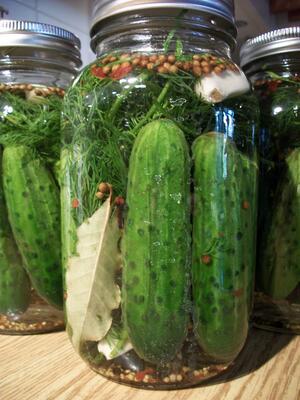Eating Jewish: Pickling Dill Pickles
The idea for this post came as I was reading Jane Ziegelman’s fascinating book 97 Orchard: An Edible History of Five Immigrant Families in One New York Tenement. She examines the foods of German, Irish, Italian and two Jewish immigrant families from Central and Eastern Europe in order to understand how each family adapted to living in America. The families' stories are interspersed with historical facts and, of course, recipes. It was while reading the story of the Rogarshevsky family of Lithuania in the early 1900s that I came across a discussion about dill pickles. Through the short section in this chapter, readers are given a glimpse into the role this popular food played on the culinary scene of New York in the early 18th century.
The immigrant’s diet was of great concern to Americans in the early 1900s, especially to dietitians as well as those who worked with immigrant communities such as settlement workers, visiting nurses, and dispensary doctors. Studies about immigrant foodways were conducted in order to understand what these new arrivals to the United States were consuming. Although certain healthy practices in the immigrant’s cooking were identified, it was the chief food deficiencies and harmful habits of these groups that were of main concern. For example, in the early 1920s, a dietitian from Boston named Bertha Woods conducted a study of immigrant eating habits identifying two of the most pressing concerns facing the immigrant cook, namely the use of too much seasoning and the consumption of too little milk.
Highly seasoned foods were seen as one of the reasons that Jews were "nervous" and one of the most objectionable of such highly seasoned foods was the much-loved pickle. Not only were pickles thought to ruin one’s ability to taste milder flavors and cause irritation, but they were also believed to render assimilation more difficult. Yet, even more alarming to the larger American community was the Jewish child’s dependence on the pickle. Jewish school kids would spend their lunch money on pickles sold in large barrels from the street vendors on the Lower East Side and eat nothing else. The way that Jewish children were drawn to the pickle was seen as a compulsion in the same way that some adults were drawn to alcohol.
I had never thought of trying to make pickles myself since they were usually something I bought. However, making these pickles was a process that was surprisingly simple. When making pickles most recipes will call for Kirby cucumbers but if they’re not available, small Lebanese cucumbers will work just as well. Salt and water (not vinegar) form the base of the brine, making these pickles less intensely vinegary as the store bought variety. When you bite into this pickle the subtle taste of fresh cucumber is preserved and after letting the cucumbers sit for four to six days, you get a pickle that is crunchy, briny, garlicky and a little spicy. A perfect pickle if I say so myself!
A food once reviled by Americans and now firmly entrenched in the mainstream food culture, what better way is there to celebrate the long history of the pickle than by making a batch of your own!
Dill Pickles
Adapted from David Lebovitz
16 cups (4 quarts) water
6 tablespoons pickling salt or kosher salt
20 Kirby or Lebanese cucumbers, cleaned
8 large garlic cloves, peeled
2 ½ tablespoons pickling spices (you can also make your own pickling spice mixture with some or all of the following spices: coriander seeds, mustard seeds, all spice, and cinnamon bark)
¼-½ teaspoon crushed chili flakes
8 bay leaves
1 large bunch of dill, washed
-
In a large pot, bring 4 cups (1 quart) of water and the salt to a boil, making sure to stir until all the salt is dissolved. Remove the mixture from the heat, add the remaining water and set aside.
-
Sterilize four 1-quart mason jars by running them through the dishwasher (you will need to remove their tops and place them in the dishwasher as well), or by filling them with boiling water and then pouring it out.
-
Separate the cucumbers among the four jars, placing them vertically in the jars and making sure they’re tightly packed in. While doing this, divide the garlic, pickling spices, chili flakes, bay leaves and dill between the jars.
-
Fill the jars with brine, making sure to cover the cucumbers completely. Place the lids loosely on the jars or cover them with cheesecloth that has been secured with a rubber band. Let the jars rest in a cool, dark place for 4 to 6 days.
-
You can taste a pickle after 3 days to see how they’re coming along. I let mine ferment for four days but you can let them ferment for up to 6 days, which will allow them to become sourer. When the pickles are to your liking, refrigerate them. They will keep in the refrigerator for one to two months (but I doubt they will last that long!)








Prefer it with out cinnamon or all spice. Glad to see that there is no vinegar in it.